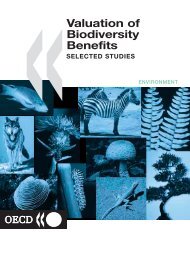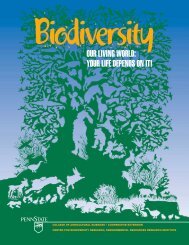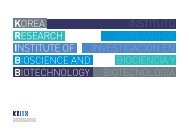You also want an ePaper? Increase the reach of your titles
YUMPU automatically turns print PDFs into web optimized ePapers that Google loves.
Article 80<br />
Complete reductive dechlorination of tetrachloroethene<br />
to ethene by anaerobic microbial enrichment<br />
culture developed from sediment<br />
Biotechnol Lett. 2010 Dec; 32(12):1829-35.<br />
Kim BH, Baek KH, Cho DH, Sung Y, Koh SC, Ahn CY,<br />
Oh HM, Kim HS *<br />
* Correspondence: hkim@kribb.re.kr<br />
Environmental Biotechnology Research Center<br />
A mixed, anaerobic microbial enrichment culture, AMEC-4P,<br />
was developed that uses lactate as the electron donor for<br />
the reductive dechlorination of tetrachloroethene (PCE) to<br />
ethene. AMEC-4P consistently and completely converted<br />
2 μM PCE to cis-1,2-dichloroethene ( cis-DCE) within 13<br />
days, and the intermediate, cis-DCE, was then completely<br />
dechlorinated to ethene after 130 days. Dechlorination rates<br />
for PCE to cis-DCE, cis-DCE to VC, and VC to ethene<br />
were 243, 27, and 41<br />
μmol/l/day, respectively.<br />
Geobacter<br />
lovleyi and a Dehalococcoides sp. were identified from their<br />
16S rRNA sequences to be the dominant phylotypes in<br />
AMEC-4P.<br />
PMID: 20714784<br />
Keywords: Anaerobic microbial enrichment; Anaerobiosis;<br />
Bacteria; Chlorine; Dechlorination; Microbial<br />
community analysis; Oxidation-reduction;<br />
Tetrachloroethene<br />
Article 81<br />
Classification of rice (Oryza sativa L. Japonica<br />
nipponbare) immunophilins (FKBPs, CYPs) and<br />
expression patterns under water stress<br />
BMC Plant Biol. 2010 Nov; 10:253.<br />
Ahn JC, Kim DW, You YN, Seok MS, Park JM, Hwang<br />
H, Kim BG, Luan S, Park HS * , Cho HS *<br />
* Correspondence: hspark@kribb.re.kr hscho@kribb.re.kr<br />
Genome Resource Center<br />
Plant Systems Engineering Research Center<br />
BACKGROUND: FK506 binding proteins (FKBPs) and cyclophilins<br />
(CYPs) are abundant and ubiquitous proteins belonging<br />
to the peptidyl-prolyl cis/trans isomerase (PPIase)<br />
superfamily, which regulate much of metabolism through<br />
a chaperone or an isomerization of proline residues during<br />
protein folding. They are collectively referred to as immunophilin<br />
(IMM), being present in almost all cellular<br />
organs. In particular, a number of IMMs relate to environmental<br />
stresses.<br />
RESULTS: FKBP and CYP proteins in rice (Oryza sativa<br />
cv. Japonica) were identified and classified, and given the<br />
appropriate name for each IMM, considering the ortholog-relation<br />
with Arabidopsis and Chlamydomonas or molecular<br />
weight of the proteins. 29 FKBP and 27 CYP genes<br />
can putatively be identified in rice; among them, a number<br />
of genes can be putatively classified as orthologs of<br />
Arabidopsis IMMs. However, some genes were novel, did<br />
not match with those of Arabidopsis and Chlamydomonas,<br />
and several genes were paralogs by genetic duplication.<br />
Among 56 IMMs in rice, a significant number are regulated<br />
by salt and/or desiccation stress. In addition, their expression<br />
levels responding to the water-stress have been analyzed<br />
in different tissues, and some subcellular IMMs located by<br />
means of tagging with GFP protein.<br />
CONCLUSION: Like other green photosynthetic organisms<br />
such as Arabidopsis (23 FKBPs and 29 CYPs) and<br />
Chlamydomonas (23 FKBs and 26 CYNs), rice has the highest<br />
number of IMM genes among organisms reported so<br />
far, suggesting that the numbers relate closely to<br />
photosynthesis. Classification of the putative FKBPs and<br />
CYPs in rice provides the information about their evolutional/functional<br />
significance when comparisons are drawn<br />
with the relatively well studied genera, Arabidopsis and<br />
Chlamydomonas. In addition, many of the genes upregulated<br />
by water stress offer the possibility of manipulating the stress<br />
responses in rice.<br />
PMID: 21087465<br />
Keywords: Cell nucleus; Cyclophilins; Cytoplasm;<br />
Immunophilins; Microscopy, fluorescence; Oryza<br />
sativa; Phylogeny; Protein isoforms; Sodium<br />
chloride; Tacrolimus binding proteins; Tobacco<br />
2010 KRIBB Article Abstracts | 47 |












